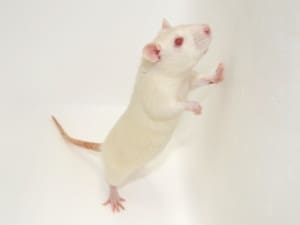SHR
SHR
| Strain details | |
|---|---|
| Nomenclature | SHR/NCrlOzarc |
| Common name | SHR |
| Synonyms | Spontaneously Hypertensive (SHR) Rat |
| Strain | Inbred |
| Coat colour | Albino (c) |
| Species | Rat |
| Genetic background | - |
| Location | Vivarium 4 |
| Supply | Tier 1: off-the-shelf, pre-allocation, breed on request |
Strain description
- MHC Haplotype RT1k
- Animals are aggressive.
- Blood pressure measured as part of Phenotype Management Plan.
- Blood pressure of 150-160mm Hg by 10 weeks of age in males and females.
- High incidence of periarteritis nodosa autoimmune in origin, myocardial infarctions, nephrosclerosis, lymphopaenia and variable incidence of cerebral lesions relative to the degree of hypertension.
- Okamoto, Kyoto School of Medicine, 1963, from outbred Wistar Kyoto male with marked elevation of blood pressure mated to female with slightly elevated blood pressure. Brother x sister mating with continued selection for spontaneous hypertension was then started.
- To NIH in 1966 from Okamoto at F13. To Charles River from NIH in 1973 at F32.
- Animal Resources Centre (ARC), Western Australia received strain from Charles River Laboratories, USA (2003).
- Stock strain is transferred to Ozgene ARC in 2023.
- Ideal of genetic hypertension, hypertensive drug research, ADHD model, safety and efficacy testing
| SHR | SHR/NCrlOzarc | |
|---|---|---|
| WKS | MALE | FEMALE |
| 3 | 20 - 59 | 25 - 54 |
| 4 | 37 - 95 | 37 - 82 |
| 5 | 54 - 106 | 49 - 97 |
| 6 | 88 - 191 | 70 - 119 |
| 7 | 142 - 229 | 101 - 140 |
| 8 | 162 - 257 | 124 - 160 |
| 9 | 189 - 273 | 132 - 169 |
| 10 | 207 - 289 | 145 - 186 |
| 11 | 174 - 252 | 154 - 195 |
| 12 | 237 - 319 | 159 - 216 |
| 13 | 244 - 326 | 159 - 212 |
| 14 | 270 - 343 | 163 - 200 |
- Animals are not allowed to be used for propagation.
- Ozgene ARC terms and Conditions
- Rat images are representative only. Actual phenotypes may vary based on genotype, sex, age, husbandry, health status, and other factors.


